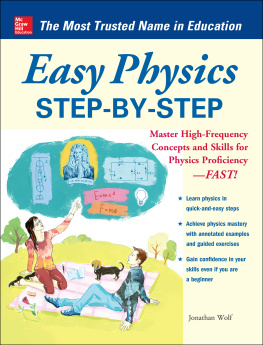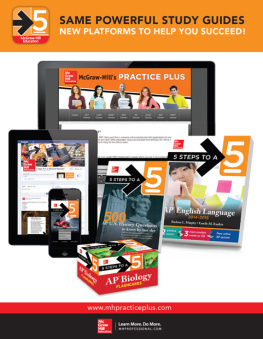

Copyright 2012 by The McGraw-Hill Companies. All rights reserved. Except as permitted under the United States Copyright Act of 1976, no part of this publication may be reproduced or distributed in any form or by any means, or stored in a database or retrieval system, without the prior written permission of the publisher.
ISBN: 978-0-07-176780-4
MHID: 0-07-176780-0
The material in this eBook also appears in the print version of this title: ISBN: 978-0-07-176779-8, MHID: 0-07-176779-7.
All trademarks are trademarks of their respective owners. Rather than put a trademark symbol after every occurrence of a trademarked name, we use names in an editorial fashion only, and to the benefit of the trademark owner, with no intention of infringement of the trademark. Where such designations appear in this book, they have been printed with initial caps.
McGraw-Hill eBooks are available at special quantity discounts to use as premiums and sales promotions, or for use in corporate training programs. To contact a representative please e-mail us at bulksales@mcgraw-hill.com.
Illustrations on the following pages by Cenveo: 4, 7, 10, 13, 19 (bottom of page), 21, 27, 36, 54, 70, 78, 80, 97, 110, 122, 145, 152, 155, 163, 171, 181, 185, 187, 194, 195, 199
All other illustration and photo credits can be found on page 209, which is to be considered an extension of this copyright page.
Other titles in the series:
Easy Algebra Step-by-Step, Sandra Luna McCune and William D. Clark
Easy Chemistry Step-by-Step, Marian DeWane
Easy Mathematics Step-by-Step, William D. Clark and Sandra Luna McCune
Easy Precalculus Step-by-Step, Carolyn Wheater
Easy Writing Step-by-Step, Ann Longknife and K. D. Sullivan
TERMS OF USE
This is a copyrighted work and The McGraw-Hill Companies, Inc. (McGraw-Hill) and its licensors reserve all rights in and to the work. Use of this work is subject to these terms. Except as permitted under the Copyright Act of 1976 and the right to store and retrieve one copy of the work, you may not decompile, disassemble, reverse engineer, reproduce, modify, create derivative works based upon, transmit, distribute, disseminate, sell, publish or sublicense the work or any part of it without McGraw-Hills prior consent. You may use the work for your own noncommercial and personal use; any other use of the work is strictly prohibited. Your right to use the work may be terminated if you fail to comply with these terms.
THE WORK IS PROVIDED AS IS. McGRAW-HILL AND ITS LICENSORS MAKE NO GUARANTEES OR WARRANTIES AS TO THE ACCURACY, ADEQUACY OR COMPLETENESS OF OR RESULTS TO BE OBTAINED FROM USING THE WORK, INCLUDING ANY INFORMATION THAT CAN BE ACCESSED THROUGH THE WORK VIA HYPERLINK OR OTHERWISE, AND EXPRESSLY DISCLAIM ANY WARRANTY, EXPRESS OR IMPLIED, INCLUDING BUT NOT LIMITED TO IMPLIED WARRANTIES OF MERCHANTABILITY OR FITNESS FOR A PARTICULAR PURPOSE. McGraw-Hill and its licensors do not warrant or guarantee that the functions contained in the work will meet your requirements or that its operation will be uninterrupted or error free. Neither McGraw-Hill nor its licensors shall be liable to you or anyone else for any inaccuracy, error or omission, regardless of cause, in the work or for any damages resulting therefrom. McGraw-Hill has no responsibility for the content of any information accessed through the work. Under no circumstances shall McGraw-Hill and/or its licensors be liable for any indirect, incidental, special, punitive, consequential or similar damages that result from the use of or inability to use the work, even if any of them has been advised of the possibility of such damages. This limitation of liability shall apply to any claim or cause whatsoever whether such claim or cause arises in contract, tort or otherwise.
Contents
Preface
Easy Biology Step-by-Step is an accessible guide designed to introduce you to (or remind you of) the core concepts necessary for developing a thorough understanding of the study of life. Each chapter presents easy-to-follow descriptions of necessary information in short, targeted text with helpful supporting images.

The Foundation checklist provides an overview of the fundamentals of the subject.

The Step-by-Step definitions of key terms will build your understanding, including devices to help you remember their meaning.

Vertigo panels provide problem-solving techniques and tips on how to demystify a problem.

Misstep panels warn you of common mistakes or misconceptions.

Following each thorough description of a new concept, a review Exercise helps to reinforce and apply new concepts.
Learning biology can seem overwhelming for a few reasons. One major factor is the breadth of information involved; biology studies everything from the organic molecules that provide the fundamental structure of living things to the complex interactions between organisms and the nonliving environment in an ecosystem. Biology doesnt skimp on depth either, for at the most fundamental level, it involves biochemistry, principles that guide the metabolism of any cell or organism.
Another issue is the sheer number of vocabulary terms involved in the discipline. While it may seem as if learning biology is like learning a new language, the more you focus on recognizing the Greek and Latin roots present in terms, the more you are building an understanding of the meaning behind a term rather than simply memorizing a definition. You will learn to predict the meaning of new terms before you ever read the definition.
Easy Biology Step-by-Step was designed with these challenging aspects of learning biology in mind. Using the written descriptions, supporting images, step-by-step problem-solving techniques, pop-up boxes, and review questions, you should be armed with the tools necessary for mastering the fundamentals of this fascinating subject.
1
The Study of Life

 Biology is the study of all life-forms and life processes. The term is derived from bios (meaning life) and logos (meaning study of).
Biology is the study of all life-forms and life processes. The term is derived from bios (meaning life) and logos (meaning study of).
 Biology includes a focus on both microscopic and macroscopic levels of organization, from cells and the smaller structures within them to tissues and organs within an individual organism and finally to the totality of ecosystems that constitute the living Earth, or biosphere.
Biology includes a focus on both microscopic and macroscopic levels of organization, from cells and the smaller structures within them to tissues and organs within an individual organism and finally to the totality of ecosystems that constitute the living Earth, or biosphere.
 Biologists characterize something as a living thing, or organism, if it possesses all six of the characteristics of life to some degree.
Biologists characterize something as a living thing, or organism, if it possesses all six of the characteristics of life to some degree.

Next page











 Biology is the study of all life-forms and life processes. The term is derived from bios (meaning life) and logos (meaning study of).
Biology is the study of all life-forms and life processes. The term is derived from bios (meaning life) and logos (meaning study of).